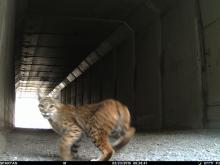Wildlife use of crossing structures that were purpose-built for wildlife and built for other needs (e.g., drainage) is critical to reducing collisions on the road surface and to maintaining genetic connectivity for populations. In this National Center for Sustainable Transportation-funded project we are examining the role of traffic noise and light, if any, on wildlife approach to and use of crossing structures. In previous studies, wildlife were on occasion found to be startled and have an aversion to stochastic or constant light and noise. This could reduce their use of crossing structures which would reduce connectivity within and among populations. We are using camera traps and light/noise meters in various habitat types to study wildlife activity in relation to traffic noise and light conditions. These conditions will vary with distance from highways/roadways, so we study animal activity at different distances from highways and crossing structures.
Project Status
Ongoing Project

